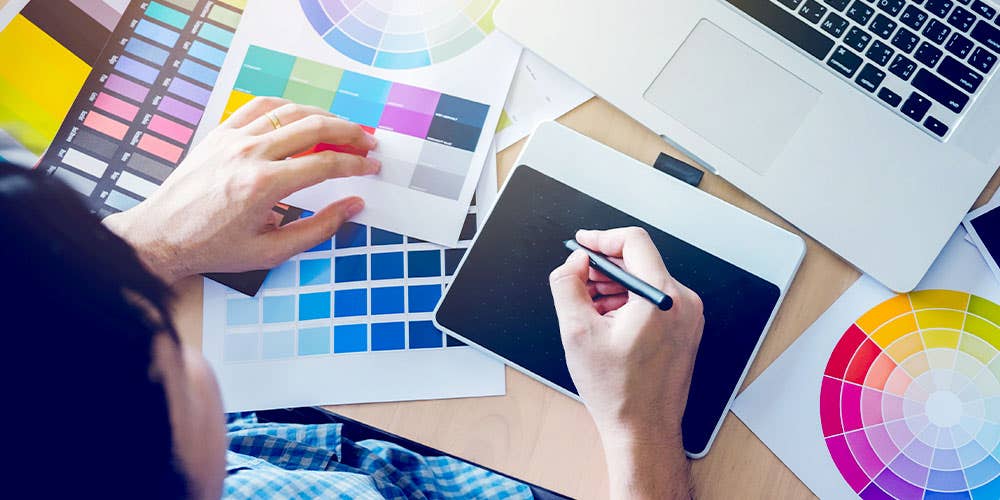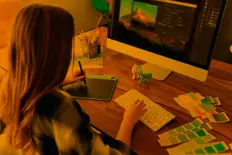Chat with Ava - Your AI Business Consultant
Hi I'm Ava, your AI guide to supercharging your business!
Whether you're already running a business or dreaming of starting one, I'm here to help turn your vision into reality using AI powered freelancers. Share your business goals, and together, we'll create a project that our talented freelancers can bid on. Let's make your vision a reality!
I have a business
I'm starting a business
Something went wrong while sending the conversation to your email. Please try again later.
You can only save your conversation once per hour. Please try again later.
Your conversation is too short. Keep chatting with Ava to enable saving.
Making Intro and Outro Graphics for Your Video
Something as simple as a professionally made intro and outro can elevate your video marketing and impress potential customers
Apr 7, 2020 • 7 minute read
Updated on Jan 28, 2021 by Gauri G.

Writer and Data Entry Professional
Copy to clipboard failed, please try again after adjusting your permissions.
Copied to clipboard.

Make your video look professional and polished with a motion graphics designer
As the name suggests, a motion graphics artist creates motion graphics. Of course, it is not as simple as it sounds. An experienced graphics artist is skilled in traditional arts and has an acute understanding of animation as well. In our increasingly digital lives, the motion graphics designed by such experts can be seen in movies, television, commercials, and just about everything else. So, if you are concerned about the casual look of your videos, then hiring a freelance motion graphics artist can be the perfect solution.
What does a motion graphics artist do?
A freelance motion graphics artist designs and creates virtual elements. In other words, they animate different graphic features and bring them to life. Such an artist is usually skilled in the following,
Animation
A motion graphics artist can bring 2D elements alive through animation. And to know how animation works, an experienced artist comes with a strong knowledge of fundamentals in this field. Using this knowledge, a professional designer can decide where to exaggerate, how to work the timing, where to ease out or stress in.
3D design
It's become nearly impossible to have a design or a motion graphic that has no 3D elements. Skills in 3D design help the artist remain relevant to the changing industry requirements.
Color theory
Color theory is a wide topic of study. However, a basic knowledge of how colors work together, what mood each color evokes, and how they're perceived by the audience can improve motion graphics by leaps and bounds. For instance, having the right color motion graphics in your video or presentation can determine the emotion that it conveys.
Typography
Considered as the driving force behind every motion graphic design, it's essential for a good motion graphics artist to have good typography skills. The artist needs to know what is easy to read, appealing to look at and complements the main product. And, they need to use typography that's consistent with your branding.
Originality and creative thinking
You want your videos or presentations to stand out. A motion graphics artist who thinks creatively and originally can deliver that for you. While every motion graphics designer has his or her signature style, they should be able to transform your idea into something attractive, original and creative.
Technical skills
It's nearly impossible to separate motion graphics from technology. Nearly all of it takes place on a computer or a laptop screen and involves different digital technologies, apps and tools. A successful motion graphics artist should have brilliant technical skills and must be in sync with the latest tools and apps.
How can a freelancer help you make your video more professional?
Having understood what a skilled and experienced motion graphics artist brings to the table, there is no doubt that a skilled freelancer in this field can transform your videos into professionally edited products.
There may be no one set formula for creating professional videos but adding certain elements, like an intro, outro, 3D graphics, etc., can significantly improve the final result.
Elements of a professional looking video
Intros and outros
Intros and outros add a structure to your video giving it a more professional look and feel. They should be simple and straightforward. They could just be an animation of your logo or a few lines telling viewers where to find more information.
Intros
An intro is a 10–15 second introduction and your one chance to capture the audience. 3 essential elements of an intro include showcasing who you are, what is your brand, and your dedication to the channel. All of these have to fit in that little time frame.
Ideally, you'll want an intro incorporating your logo that can be used with every video. You may also want to add a secondary intro that introduces the title and topic of the specific video.
Outros
Outros, or "endslates,’ come at the end of your video. If the person watching your video reaches the end, then you can add a call to action in the form of a free guide, a download, or a blog post. The outro can also include a subscription button or a video clip. The primary idea is to remind the viewer to get notified of future videos.
Lower thirds
The aim of a well-designed lower third is to help your audience understand the context of the video more easily. It is a graphic overlay that is placed in the lower third area of your screen. It is used to provide extra information about the video. This helps improve the viewer’s experience while watching your video. Therefore, it is very important to get this right.
Animation
You can easily incorporate your brand name or logo in the intro and the outro without professional help. However, these still images may not be enough to engage the audience. Getting a professional to add appealing animation and graphics can generate interest for the upcoming video.
Sound
The music track must go suit the animation. The graphic designer will use their skill and experience to match the mood of the video and the animation to the music. Ultimately, both intro and outro work like bookends, wrapping up the content perfectly.
Above everything else, all elements must be catchy and crisp. Hence, hiring a professional motion graphics artist is a smart choice. The artist can help you design an intro or outro that includes all the essential elements, is interesting, and fits in a 10-15 second window.
Popular tools used by a freelance motion graphics artist
When it comes to tools for creating and designing motion graphics, there is certainly no shortage. Typically, each designer will have a set of preferred software tools that they may use to enhance their videos and presentations. We have compiled a list of such tools that are most popular among freelance motion graphics artists.
Adobe Photoshop
While most of us use this software for retouching or basic editing, Adobe Photoshop is capable of much more than this. This creative software program is rich in features and the most wanted tool for any motion graphics artist. It helps them churn out some of the best design elements for their motion graphics project. A motion graphics designer will use Photoshop to edit textures, design matte paintings, layout animations, design boards, create GIFs, etc.
Adobe Illustrator
Despite being an Adobe product, the Illustrator offers entirely different features from Photoshop. As a vector-based software, it comes with an array of tools suitable for creating brilliant pieces of motion graphics. The motion graphics artist will use Adobe Illustrator to design vector elements like shape objects, logos or vector backgrounds.
Cinema 4D
Cinema 4D is one of the most popular software in this field. It comes bundled with features like 3D modeling, motion graphics, and animation. The software is scalable, flexible, and integrates easily with other tools like Adobe Illustrator and Adobe After Effects. Motion graphics designers use Cinema 4D to create high-quality 3D graphics.
Adobe After Effects
After Effects is another brilliant software from Adobe. This computer animation software application allows users to complete a variety of animation projects in 2D modeling. But most importantly, this tool helps the artist stimulate and combine all the motion graphic works together in the defined sequence. In other words, it is an extension that helps the designer carry the motion graphics.
Adobe Premiere Pro
The Adobe Premiere Pro is the most popular video editing software that is used extensively by professional motion graphics artists. With a sound knowledge of basics in video creation, you can produce professional-grade content using this tool. It is considered as the finest movie editing software and allows users to adjust sound, color, etc.
How to find the right freelance motion graphic artist
Before you begin your search for a freelance graphics motion artist, be clear on your requirements. The best way to do this is to list down your expectations and create a questionnaire to shortlist the best candidates.
You can then begin to review candidate profiles on prominent freelancing websites. Since the work is done remotely, you can pick up profiles from anywhere in the world. See their experience, skills, education, certifications, etc. and create a shortlist of candidates you would like to interview.
Interview questions can range from their method of communication to the areas they specialize in. These questions must be designed to end up with the best possible freelancer that can render a more professional look to your video.
What do you need to give a freelancer?
Once you have interviewed and hired the freelancer, it is time to share a project brief. Unlike the name, this document should contain everything you feel the professional needs to know to deliver the project as per your expectations. These can be a background, technical details, flow of communication, any samples that you like, project timeline, etc. You should also provide them with any digital assets they'll need, such as a PNG or PSD of your logo and any music you want to play over the intro or outro.
Final words
With the variety of tools and software applications, adding motion graphics to videos is no rocket science. However, getting the video edited by a professional can give that required edge where everything has a unified flow. Fortunately, you don’t have to hire expensive services of a company specializing in motion graphics as freelancing is exceptionally popular with motion graphics designers. All that you have to do is log on to a reputable freelancing website and post your project requirements. You will have suitable profiles reaching out to you in no time.
Tell us what you need done
Enter your project name
Related Stories
Talk to one of our Technical Co-Pilots to help with your project
Recommended Articles Just for You

A great television commercial can become a cultural touchpoint that people remember for years. Here's how to make one on a budget
9 min read

Animated videos can add some serious flair to your marketing. We'll show you how to get them done, who to hire and what you need to provide.
7 min read

What type of graphic design should you use for business? In this exhaustive guide we discuss every different type of design your business might need.
23 min read

Finding the right freelance graphic designer for your project can be easy if you know the right questions to ask and the skills to look for.
5 min read
Thanks! We’ve emailed you a link to claim your free credit.
Something went wrong while sending your email. Please try again.
Loading preview
Permission granted for Geolocation.
Your login session has expired and you have been logged out. Please log in again.




